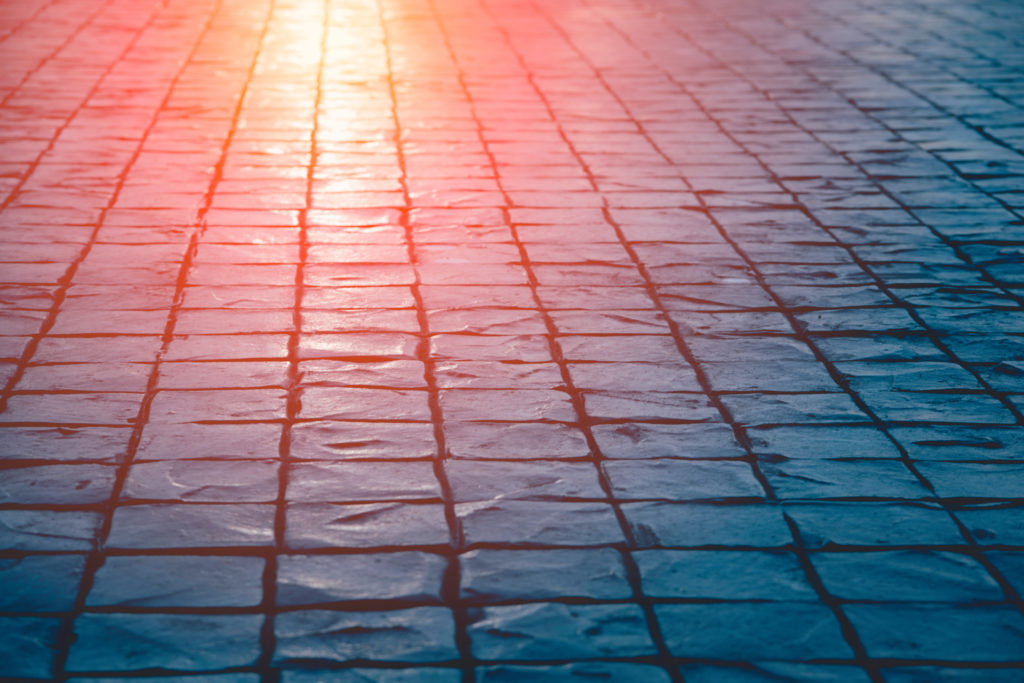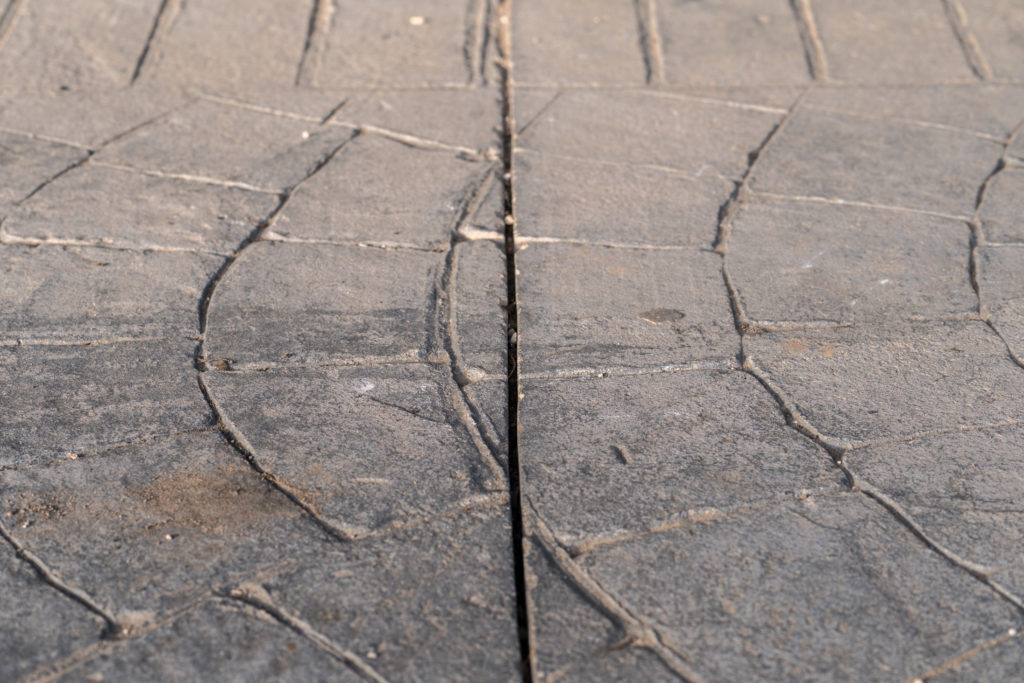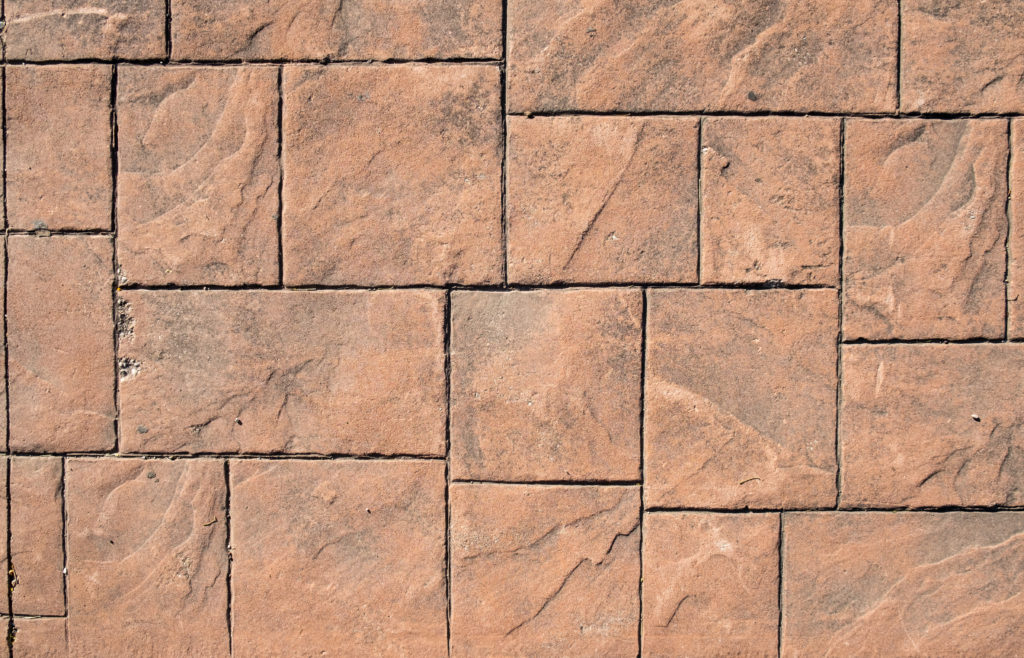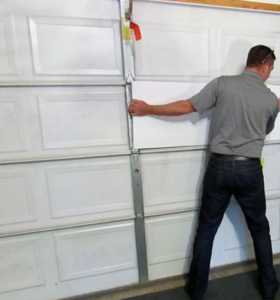Stamped concrete is a fabulous and affordable paving option for driveways, patios, walkways, pool decks, and floors.
This is because the design options are vast, the maintenance is minimal, the installation is fast and the price can be very affordable depending on square footage and design choice.
However, every paving option has its pros and cons.
To learn more about whether stamped concrete is the right choice for you, read on.
What is stamped concrete-
Stamped concrete is a concrete slab that is “stamped” with a chosen color & pattern in order to look like natural stone, tile, wood, brick, or other paving options. Essentially, it’s the same thing as a traditional concrete slab but spruced up with color and texture.
So, why has it become such a popular option?
Well, for one, it’s typically cheaper than stone, wood, or brick. Aesthetically, a similar feel can be achieved with the right pattern and color theme.
It’s also fairly easy and fast to install although we wouldn’t recommend this as a DIY project unless you are versed in concrete. Concrete experts know the ins and out’s of the trade. Laying concrete isn’t as simple for the average “lay” person.
The right mix must be used and factors such as soils, climate, and water management must be considered and catered to during installation. If these factors are not considered, you’ll have to deal with mother nature’s wrath in the form of frost heave aka a shifting/cracking mess of a project.
Many times, concrete professionals will actually hire a geotechnical or structural engineer to create a water management plan to ensure proper drainage, preserving the project at hand for years to come.
The problem with stamped concrete is that if you mess up, there’s no going back; you’re stuck with what you have unless you want to spend the money to tear it out and start over.
It’s definitely worth it to pay an expert to do the installation. It will be done in no time and ready for your enjoyment.
Something else we love about stamped concrete is that it’s much more weather-resistant than pavers such as brick or slate. We’ll get into this more later.
What type of projects use stamped concrete-
You’re probably wondering how stamped concrete is used. It’s actually very versatile and can be used both externally or internally.
Typically, however, you will see it being used on patios, driveways, walkways, pool decks, floors, walls/fireplaces, or fire pits.
Here are some examples of what we are talking about.
You see, the options are endless. If you are looking for a paver-type material to make your project look beautiful, stamped concrete could be one option to consider.
As long as your contractor or structural engineer implements a solid water management plan, stamped concrete will hold up nicely.
If you’re wondering how long it will last, read on to the next section.
Does Stamped Concrete Last-
Stamped concrete lasts about as long as standard concrete, 25 years. It can last even longer if it’s properly installed and maintained.
So, what does that look like?
Well, proper installation is paramount. Remember, installation is more than correctly pouring the concrete (this is an art in itself). It also includes grading and correct soils.
You may have heard that stamped concrete is not meant for roads & driveways. Well, this is because many installers don’t understand soils & water management. If the correct soils are used and water is being shed away from the stamped concrete, it will hold up just fine.
So what are the correct soils?
Well, first off, they need to allow water to flow through them. The best subgrade soils would be something like a compacted red rock gravel aggregate or conbit.
The worst soil you could build on would be alluvial clay. This is because clay holds moisture and leads to movement and therefore cracking of the building materials above.
This is the biggest reason for concrete surfaces failing and cracking. Water is the enemy.
Concrete also requires expansion joints. Without these, your slab will crack.
Why?
Well, concrete is susceptible to expansion and contraction from temperature and moisture changes. So, as temperature and/or moisture increases, expansion occurs. As temperatures and/or moisture decrease, contraction happens.
Without a system to manage these factors, cracking is inevitable (keep in mind, even with a great system in place, some cracking may still occur). The system needed to control and minimize concrete cracking involves expansion joints.
To learn more about this, check out a great article here.
Another installation & maintenance tip for lasting stamped concrete is to ensure a concrete sealer is applied post-installation and reapplied every 3-4 years. This sealant will help keep the elements away from the concrete and ultimately prolongs its lifetime.
If you are wondering if your stamped concrete needs to be re-sealed, take a look at it. Does it look dull and faded? If so, it’s time to apply sealant. This sealant will give your stamped concrete the facelift it needs to restore it to its original beauty.
On a final note, work with your contractor and manufacturers when choosing a design. Some designs are more prone to cracking especially on driveways. A design specialist should be able to give you the pros and cons of each style you like.
Get a free quote on your project!
Ready to start your project? Reach out to Complete Building solutions and get a quote absolutely free.
How is stamped concrete installed-
The installation process of stamped concrete is pretty much the same as traditional concrete with a few extra steps.
Here is the step by step process:
- Subgrade Preparation- We talked about the importance of subgrade earlier on. Make sure the soils you are building on do NOT hold moisture. If you aren’t sure what soils are present, get a soil test done or hire a geotechnical or structural engineer. The best subgrade to prevent concrete cracking is a compacted conbit soil. Compaction is very important, don’t skip this step.
- Placing Forms- Forms are important for reinforcing concrete and prolonging lifespan. The type of form you need depends upon the size and scope of the project. However, most concrete forms for flatwork projects like patios, driveways, sidewalks, roads will be approximately 3-12 inches in height and made from wood. The form needs to be designed to accommodate the proper slope for drainage.
- Installing Rebar- Next, install steel reinforcing bars. This step is crucial because it provides the slab with structural integrity, impact resistance and helps protect against cracking.
- Pour Concrete- It’s time to pour the slab. It’s common for a ready-mix truck to arrive at a scheduled time and pour the concrete. Remember, the type of concrete used is important. Discuss mix design with your contractor. Another note, if using integral color, you may have ordered pre colored cement or may add it to the back of the cement truck here (make sure you have discussed and planned this ahead of time).Read here for a great article on this.
- Screeding & Finishing the Concrete- Yet another crucial step to a successful stamped concrete project; this is where leveling takes place. Screeding prevents high or low spots in the surface and must be done immediately after the concrete is poured.
- Color Application- If your contractor is not using integral coloring, your color hardener will be added here. It adds an additional step to the process but can offer up to 1,500 psi in additional surface strength as opposed to integral coloring. Check the link in step 4 for more info.
- Stamping- All hands on deck for this phase of the process since time is a factor. This is why planning ahead of time is essential.
- Curing Stamped Concrete- Now it’s time to allow the concrete to dry. If done correctly, the concrete will actually thicken and become less permeable with the drying process. This is important for keeping moisture out and increasing surface strength.
- Installing Joints- Remember when we talked about the importance of expansion joints? Well, this is when they must be cut into the slab. They will be strategically placed throughout the slab to help reduce the risk of cracking.
- Sealing Stamped Concrete- Apply the concrete sealer. Not only does the sealer have some heavy duty functional jobs like wicking moisture away from the slab, but it also creates a shine that is very aesthetically pleasing. Remember to re-apply concrete sealer every 3-4 years.
Does stamped concrete need a concrete sealer-

Yes. Stamped concrete 100% needs a concrete sealer. The biggest reason is that it helps to prevent moisture from working its way into the concrete. Since we already know that water wreaks havoc on concrete, we want to take measures to stop it.
A concrete sealer has other purposes too. It does things like provide protection from the sun’s harmful rays and prevent stains from dirt, salt, oil, and other materials.
Also, aesthetically, it really makes your floor “pop” by providing extra shine. You’ll know when you need to reapply sealer because your floor will start to appear dull.
Keep in mind that there are many different types of concrete sealer, each with a specific purpose. When choosing the right sealant for a project you may consider the following criteria: cost, dry times, availability, life expectancy, and is the product a solvent or water-based.
Outdoor stamped concrete projects typically call for solvent or water-based acrylic. There are many pros to an acrylic sealant including: easy to apply, affordable, UV resistant, non-yellowing, and breathable (letting trapped moisture in the slab escape). It’s these features that make acrylic concrete sealants popular for exterior stamped concrete.
Indoor stamped concrete projects will probably go with a water-based acrylic over a solvent. This is because the VOC fumes are quite hazardous and can lead to health issues for homeowners.
Will stamped concrete crack-
The answer….it can. It probably will crack if your subgrade isn’t perfect. By perfect we mean correct soils, proper compaction, and grading that leads water away from the concrete. If these components were not addressed during installation, stamped concrete may turn into a mess after a few years.
If soils & grading were implemented correctly your stamped concrete project should hold up quite well. Especially if expansion joints were installed according to manufacturer specs and a proper sealant was added and maintained.
Can stamped concrete be resurfaced-
In many cases, stamped concrete can be resurfaced.
However, if your concrete is in rough shape, meaning large cracks or significant settlement have developed, resurfacing may not be feasible.
If you are unsure whether your stamped concrete project can be resurfaced, reach out to a professional.
Resurfacing a slab in good shape is typically straightforward. It is possible to eliminate the stamped pattern completely (leaving the existing slab intact) or to use your current concrete as a base for a new pattern.
The first option would simply mean covering the existing pattern with new concrete. Of course, there is a process that would need to be followed. For instance, you must wash the concrete first, remove the old sealer or etch, and consider primers to help hold the new concrete surface to the old concrete surface.
The later option, would entail exactly what we mentioned above, but then stamping the new & different chosen pattern before the new concrete has dried.
Should I pressure wash my stamped concrete-
No, pressure washing can break down your sealer and allow for moisture penetration. Instead, do this.
Steps for cleaning stamped concrete:
- Use a garden hose to rinse the surface
- Scrub with a broom and, if needed, use a tiny amount of liquid dish soap
- Rinse. Pay careful attention that all soap is removed.
If you are unsuccessful you could consider hiring a professional with knowledge in cleaning concrete.
Is stamped concrete slippery especially around a pool-
Yes, stamped concrete can be slippery especially around a pool deck. It is more slippery than regular concrete because of the smooth finish.
Do not panic though. There are techniques that can help to some degree.
One method is to mix a non-slip additive to your sealer before rolling it on. Many professionals will tell you that this helps but does not create a completely “slip-free” floor.
Another option is to “seed” the concrete with a color hardener. This again improves the grip factor and may actually be a better option than non-slip additives because it will last longer. Again though, this technique only improves grippiness, it doesn’t create a slip-free floor.
Which is better: stamped concrete or concrete pavers –
As engineers, we have to approach this question from a structural integrity standpoint first.
- What’s stronger? Pavers
Pavers win that battle hands down. They are typically around 8,000 PSI or greater whereas poured concrete sits somewhere between 3,000-4,000 PSI. Concrete is much more likely to crack from too much weight or frost heave. Even if pavers were damaged, they are easier to replace since they are laid individually and are not one continuous slab.
- What’s more affordable? Stamped concrete
Stamped concrete is the winner in the budget department. Both labor and materials are more affordable than pavers. Concrete may be anywhere from $6-$12 per foot installed while pavers cost $8-$25 per foot installed. Some pavers can even cost upwards of $50 per foot.
- Easiest installation? Stamped concrete
It makes sense that stamped concrete would be an easier install (in nearly all cases). Concrete can be poured in one fell swoop. This is contrary to pavers which must be laid individually which of course takes more time and labor.
- Maintenance? Both
There are pros and cons to this one. Concrete is definitely easier to clean than pavers, but it does require new sealant every 3-4 years. Pavers do not require sealant but present the issue of cleaning between the pavers themselves.
- Design Options? Both
Both pavers and stamped concrete offer hundreds of design options. Whatever your design preference is, it’s likely you’ll be able to find it with both products.
- Curb appeal? Pavers
Pavers are an absolutely classic look. Many modern surveys show that homeowners still prefer pavers over stamped concrete.
So, which is better? As you can see there are pros and cons to both. If you are struggling to decide, ask a professional which product would hold up the best with your climate and design.
Common stamped concrete patterns-
The options are endless when it comes to stamped concrete patterns. Some of the most common pattern styles are: brick, slate, stone, wood, and flagstone. Within these categories, there are many variations. See the photo below.


The photos above show some examples of the various patterns available. If you like stone, great. Do you want cobblestone, random stone, London stone, Caesar stone, Yorkstone, or another type of stone? What color would you like your stone pattern to be?
You have options.
If you want to see more stamped concrete patterns, check out this website.
Here is another gallery with great stamped concrete pattern options.
What does stamped concrete cost per square foot: is it expensive? –
Ok, let’s get into the nitty-gritty on what stamped concrete costs. Is it expensive?
Time to talk about money.
1. Fundamental Cost-
It’s completely possible to get a beautiful product for low cost.
When you stick to the basics, your stamped concrete project could cost you $8-12 per square foot.
This typically would include: One stamp pattern and one color.
2. Middle of the road cost-
If you want to go a step up and incorporate multiple patterns or add a border you could expect to pay $12-18 per square foot.
This price may get you: Multiple borders, multiple patterns and/or multiple colors.
3. Upscale cost-
If you want to go all out, your stamped concrete project could cost upwards of $18 per square foot.
With a price point like this, you can expect a very realistic and unique feel to your stamped concrete. It could include: multiple stamp patterns, multiple colors, custom designs, and even hand coloring.
Let’s get into the specific costs of popular stamped concrete projects.
How much is a stamped concrete patio?
Are you looking to install a stamped concrete patio? If so, we will give you a rough idea of what that may cost. The Concrete Network says that an average patio size is approximately 288 square feet.
So, the cost to install a stamped concrete patio could be as follows:
Fundamental- $2,300
Middle of the road- $3,500
Upscale- $5,200
There are many factors that could affect your stamped concrete patio price.
Size- The size of your patio will affect the costs. Square footage generally goes down as the patio size increases. Remember that some contractors will charge a minimum.
Design- The more intricate your design, the more cost will increase due to materials and labor.
Soils & grading- We’ve talked about this a lot so far. If your property has poor soils in the subgrade or bad grading, you will need to fix this. That can significantly increase your costs.
Resurfacing- Oftentimes it is possible to resurface your existing stamped concrete patio for $3-10 per square foot. This may be a better option than completely starting over.
How much is a stamped concrete driveway?
Again, the concrete network says the average 2-car driveways are 16’x 40’ for a total of 640 square feet.
Fundamental- $5,120
Middle of the road- $7,680
Upscale- $11,520
Let’s talk about some factors to consider regarding your stamped concrete driveway price.
Thickness of driveway- It could be possible that your driveway only needs to meet the minimum requirement of 4 inches in depth. However, it’s smart to speak with a structural engineer on this especially if you plan to have high volume traffic or heavy-duty vehicles parked in the driveway. Of course, if you need a thicker driveway, costs will increase.
Design- The more intricate your design, the more you will pay.
Soils & grade- Again, soils and grade are popping up. If you don’t want cracking to occur, this step is essential. Things can get a bit more complicated if you live on a steep slope or at the bottom of a hill. A geotechnical or structural engineer can provide you with a great water management plan to counter this. In this situation, you may have to budget for excavation or engineering costs.
How much is a stamped walkway?
Every single stamped concrete walkway is unique in size and shape. Therefore, it’s impossible to give an average cost breakdown.
Things to consider:
Size- Many contractors have a minimum fee, so if you are installing a small stamped walkway, your labor costs could be high. Also, the price per square foot of stamped concrete will decrease with a larger-sized walkway.
Soils & grade- Costs will increase with poor soils and grade.
Shape of stamped walkway- Straight aways are easier to form than curvy lines. Costs will increase with more curves.
Design- As expected, costs will increase with more intricate or custom designs.
Just to recap, we’ve gone through what stamped concrete is, some of the pros and cons to using it, costs, how it compares to pavers, as well as installation, maintenance, and longevity tips
We hope you found the answers you were looking for within this article.
If you have any further questions regarding stamped concrete, please reach out at 763-544-3355.



